Menus
- Born adventurers !
- Discovery
- In the saddle
- Contact
- In the city
- Highway
- Departmental
- All Terrain
- Brakes
- Comfort
- Consumption and maintenance
- Convenient
- Conclusion
Born adventurers !
Funny fate that of the sidecars! Popular and family vehicles par excellence from the beginning of the last century until the 1950s, when post-war governments launched major industrial plans aimed, among other things, at democratizing the private car for the working classes, they have since almost disappeared from the "Mass market" with the fall of the Wall and the obsolescence of the MZ 250 and Jawa 350 harnessed, which then constituted the last affordable proposals of the genre. Today, the sidecar has become a machine as furiously offbeat as it is rare on our roads, attracting a motley class of activists, originals, anti-conformists and epicureans, not to mention those who have to deal with a physical disability and who see it as a nice palliative to the practice of motorcycling.
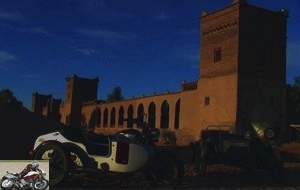
Let’s not forget the adventurers, because the sidecar is only a bitza combining the disadvantages of the car and the motorcycle (which it is especially not), it is above all a beautiful travel machine placing its pilot in a very unique universe. This is evidenced by their power of seduction with passers-by aged 7 to 77, still intact and, frankly, which is a permanent source of amazement (and joy and sharing). It would seem that in the minds of the general public, the maxim of sidecar drivers that, "from Tintin to Indiana Jones, all heroes ride sidecar …. »Be present.
We are therefore presenting you exclusively (yes!) An unprecedented face to face between two credible proposals intended for those for whom motorcycles must always have an aftertaste of adventure and escape.
Discovery
Our two machines embody, each in their own way, a certain expression of travel far and far from the beaten track. The first looks like a 3-wheeled Jeep Willys, which can be attributed to their common military origins..
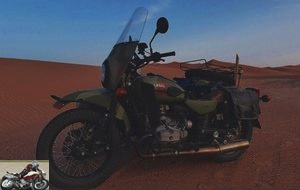
The Ural brand appeared at the start of World War II, reproducing the German BMW R71, a motorcycle that was already outdated since it still had recourse to a technology using side valves. Without going into detail in the history of Ural, paradoxically as rich as it is not very evolutionary, the development of motorcycles took place with a certain parsimony. Among the milestones, we note the switch to 650 tumbled engines (still flat twins, of course), in the early 1970s, when Ural was one of the largest manufacturers of large displacement motorcycles in the world (c ‘ is hard to believe, but it’s true)! The return to the 750 was made in 2003 and in 2008, the new owners of the brand changed a large number of suppliers in order to improve overall reliability: the gearbox was then entrusted to the Germans of Herzog, the pistons to Mahle, Keihin carbs, SKF bearings, Ducati electronic ignition, Brembo front brake and Paioli fork….

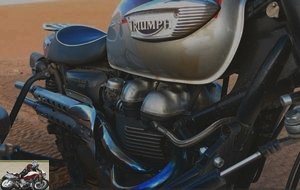
New revolution in 2015, with the appearance, anti-pollution standards oblige, of EFI models with electronic injection, improvement going hand in hand with the arrival of disc brakes at the rear and on the side, of a steering damper hydraulic, as well as some changes in the presentation of the bike. Today, the Ranger 2WD (the side wheel becomes the driving force, after engaging the transmission running transversely from the rear wheel of the motorcycle), constitutes the most “adventurous” version of the Ural range, with a rich entry of range, the cT, offered at € 12,650, more equipped Tourist models and its 2WD Sportsman version, as well as the Retro with a lowered and more classic line. The Ranger is extremely well equipped from the outset: additional headlamp, flag holder, spare wheel, luggage rack, windshield and complete fairing, sand removal shovel ….
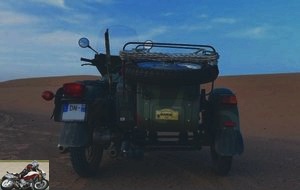
Only the foot to install a submachine gun in front of the basket has recently disappeared at Ural. We won’t complain.

Opposite, we are on another interpretation of the concept of the side adventurer, but there is still a real common point between the Ural and the Triumph Scrambler Yeti: the side body is identical and comes from the same suppliers.
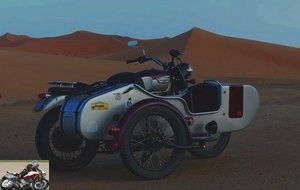
The Yeti is made by CS Concept, a Parisian craftsman specializing in classic and neo-retro sides. CS Concept mainly harnesses Royal Enfields, Moto Guzzi V7s, Triumph Bonneville and Scrambler; the 2016 Bonneville range is one of his projects. On these few carefully chosen machines, CS Concept offers a la carte several assemblies: the Black Pearl is a classic side, while the Aiglon from Precision seduces with its authentically vintage side and its aluminum finishes. For frequent travelers, CS Concept offers the Yeti as well as, on request, a basket more specifically intended for exploration and crossing, the Dzo, which its designer took to the peaks of the Himalayas last year.
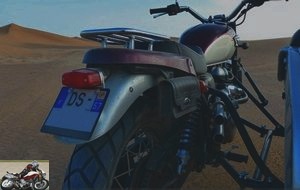
In the saddle
Advantage of the side: no need to put your feet on the ground! As these are two bikes with fairly traditional ergonomics, it won’t be surprising to find yourself quickly at ease on board, with relaxed and comfortable riding positions in both cases, despite the Triumph’s aftermarket handlebars. All orders are naturally to hand; However, it will be necessary to familiarize yourself with the Ural which, on the right side, has three different controls for reverse gear, the parking brake and engagement of the second drive wheel. We also note that the frame of the Ural leaves a little less space for the right foot than its competitor of the day.
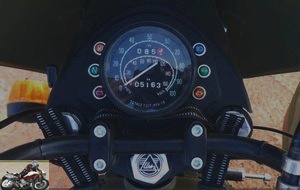

And since a side can be shared, obviously there is no difference in the accessibility of the basket, with well-cut openings and enough space to lengthen the legs. Equality for the monkeys, therefore !
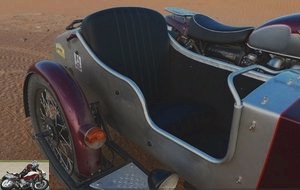
Contact
Common point on our two machines: an ignition key installed on the left side of the headlight. The Triumph does not have a parking brake: we will use a large elastic which allows the front brake to be stuck..
Ural’s new dashboards have six lights, compared to four previously, with a standby indicator having appeared. For the rest, we are dealing with a large meter stuck in a support in good Siberian plastic. The Triumph was fitted with an adaptable speedometer, delivering only speed and a few indicator lights. This was the case with the original Triumph Scramblers anyway, which only got into the tachometer late..
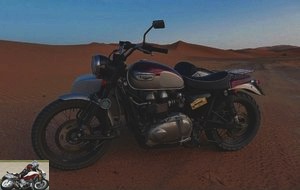
Another special feature of our Scrambler of the day: the Yeti was built on the basis of a carburetor model. So there is a starter on the left side; in this sense, it is like on the more modern injected models which hide their injection in false carbs and which have an enhancer on the left, for cold starts. Our Scrambler was also equipped with a Dynojet kit and a little "loose" exhaust, if not a lot. The Scrambler therefore comes to life in a rather joyful explosion, while the sound of the Ural is reminiscent of that of a Citroën 2CV, much more subdued ….
The controls of the Triumph will not disorient the regulars: everything is precise, with a selection of reports a little firm and little travel. On the Ural, modernity has not transformed the fundamentals. There is a little less overall precision in all the controls and the gearbox, with a dual-branch selector, is slow, (very) firm and noisy at the same time..

In the city
You will quickly understand that the great city is not the playground for sidecars, which quickly suffocate in traffic. With their substantial dimensions (they are both more than 1.7 meters wide!), It is impossible to play with the traffic as much as the Ural, supplied as standard with a small oil pan. (most owners have a larger capacity crankcase fitted with fins for cooling), don’t really like traffic jams where it tends to heat up quickly.
In short, if the Ural seduces by its reverse gear and its lockable trunk (but the lock is really messed up, since it is possible to break the ignition key in its housing if you do not forget to remove before operating the handle), the Triumph is lighter and more manoeuvrable and more pleasant to drive in this environment with its soft controls.

Highway
Why not, even if our two machines have a preference for traveling in a wandering mood. But if we have to cover as many kilometers as possible in a minimum of time, our two vehicles are there…. each in their own way.
The Ural Ranger, with the protection it offers the crew, is a big thumbs down to the weather: it slices through the wind and rain without flinching. This is the machine for real backpackers, who do not ride fast but for a long, long time! On the other hand, its modest power (the injection brought the flat twin from 39 to 40.5 hp) and its 4 gearbox do not give it a fantastic range. Depending on your sensitivity to the mechanical thing, the ideal cruising speed will be between 80 and 90, with few owners daring to maintain 100 km / h indefinitely. In strong headwinds, it will suffer a little with its generous frontal surface and will have to reduce its cruising speed further..
Opposite, the Yeti Scrambler appears overpowered! Its 57 horses (at their peak on our test machine!) Allow it to cruiser 130 km / h without flinching, or even more where the law allows. Its smaller tank (16 liters instead of 19), the lack of protection for the rider and passenger and its unreasonable consumption above 120 km / h will lead to more frequent stops. In both cases, nothing to say about the stability of the sides, although the Ural always requires a little more effort on the handlebars..
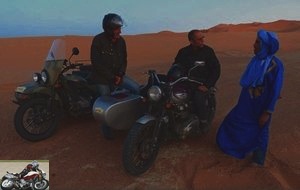
Departmental
It is of course in the countryside that these vehicles give their best! Before going into details, it is important to tell those who have never ridden on a side, the architectural specificities of the machine.
A side is an intrinsically unbalanced vehicle: depending on the assembly, we can say that the weight distribution is 2/3 – 1/3 on the bike and the basket. If we add a solo pilot, it goes to ¾ – ¼. On the road, the motorcycle wheel is not driving and it is not always braking. In short, the side doesn’t really like turning left, but forcing it a bit, it’s okay.
He hates turning to the right and you absolutely have to respect that: you have to sacrifice your corner entry and arrive at reduced speed, constrain him by steering and stretching out his left arm, rounding his trajectories, accelerating slowly while looking far away. And it passes. He also doesn’t like straight lines, where he copies irregularities in the road, pulls right under acceleration and left under braking. If you have not yet started running in front of so much incongruity, know that on the handlebars, the (intense!) Pleasure results from the mastery of holding this improbable machine on the road, in a tango of awkward sensuality.

Raised on 19-inch wheels, weighing 365 kilograms empty, the Ural is heavy and inert. Its direction is heavy. On the side, the height of the center of gravity plays a considerable role and on more basic Ural models (like the cT, with its 18-inch wheels), the gain in agility and stability is anything but anecdotal. In short, the Ranger does not usurp its all-terrain adventurer attitude; you attack the mountainous departmental roads on your handlebars with the same caution as you would take behind the wheel of a Land Rover I-Series without power steering, with a roll phenomenon occurring at each corner entry. The Ranger effectively sets a calm pace, where anticipation is set up as rule number one. With the switch to injection, the flat-twin’s performance was less impacted than its temperament: the engine is now smoother and rounder. And as on the handlebars, we have no other choice than to ride coooool, we appreciate the fact that we have gained flexibility at low and mid-range. The gearbox is still very agricultural in its operation, firm, noisy and slow, but the flexibility of the flat twin which allows to start again on a trickle of gas in fourth at 60 km / h, is an asset. Considering the performance, the braking, now using three discs (instead of one disc and two drums previously), is satisfactory.
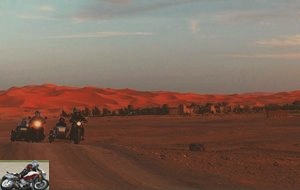
More powerful (57 hp instead of 40), lighter (315 kilos), the Yeti is obviously more lively and responsive than the Ural. Optimized by the Dynojet kit, the vertical twin of the Scrambler is appreciated by its large torque available from the lowest revs, which gives it, in addition to very honorable performance, this very appreciable feeling of being able to rewind quickly and comfortably without forcing. Its Hagon shock absorbers also give it greater rigor. This has two consequences: a greater feeling of ease and safety at the same speed, as well as the desire to go and provoke him to quickly realize the excellent balance of his chassis. The Yeti is much more communicative for its pilot, who will feel very precisely the moments when the basket is about to rise, or even who will precede this moment with a little throttle coming out of a turn. The Yeti’s Mitas Enduro tires are also more considerate than the Ural’s Duros; they stall a little later on the asphalt and remain very controllable in the management of the glide, whether it is under acceleration or braking, in particular in the turns to the left where one helps the Yeti to turn even faster. ” a slight blocking of the rear when entering a turn.
All Terrain
The Yeti’s large Mitas Enduro tires and the responsiveness of its vertical twin make it a real toy on rolling tracks. Less lively and heavier, the Ural will have to adopt a calmer pace, before releasing its master asset in the event of a major difficulty: by engaging the transmission from the side, the Ural Ranger 2WD therefore becomes a two-wheel drive and regains its true nature.
Please note, the Ural does not have a differential: the 2WD function is therefore reserved for specific crossing times, at reduced speed, and you will then have difficulty maintaining directional power. But it will save you the trouble in a sandbank, in a scree, a muddy river bottom, or even to cross the pass of a very snowy winter! All this within the limit of tire grip, of course.
If that’s not enough, the Ranger has a second bonus: a shovel !
On the other hand, this Ranger 2WD EFI is not delivered with the "Ural Survival kit" which fitted some models of the previous vintages: in a small box attached to the basket, Ural originally delivered a survival kit consisting of a box of sardines, a packet of chewing gum, a box of condoms and a small bottle of Vodka !
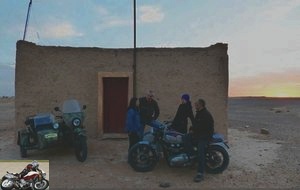
Brakes
Before testing the brakes, be aware that when braking, a sidecar will pull to the left! In terms of device, the Ural seems to be the best equipped with its three discs, since the Yeti does not have a brake system on the side..
In fact, Ural retains the advantage, with a caveat. Using the front brake causes the side to pull to the left, which we normally know how to handle. But the distribution of the braking power at the rear, with a larger disc on the side than on the bike, pulls the bike to the right, with a Siberian lambada movement if you apply both brakes hard. Strong stomachs won’t care.

No one in their right mind ever really considered the Triumph Scrambler to be an outstanding brakeman. With the added weight, this is not changing for the better. Nevertheless, a well-driven side is driven with anticipation and during this test, where I did almost 1500 kilometers on the Triumph, I was never surprised by the braking..
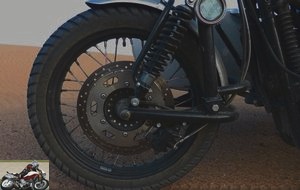
Comfort
CS Concept installs Hagon shocks on the Triumph, instead of the poor stock components. Let’s put it bluntly: the accuracy of the rigor / comfort compromise is transformed and the balance of the chassis is a strong point of the model.
Opposite, Ural does not play in the same court while offering more. The suspensions are less rigorous but smoother at low frequencies, the protection is royal, the exhaust is both in the low position and twice as quiet, unlike that of the Scrambler which explodes in the monkey’s ear. For the passenger, the Ural’s necessarily more placid handling is also part of the comfort experienced on board. In short, it’s better, even if searching the kilometers by hundreds on the Yeti is not a punishment.
Especially since the overall comfort does not only integrate parameters such as the size of the windshield, the softness of the seat or the suspensions.
The Ural, here, pays again to its dated design: everything is hard, between the gearbox and the steering which, on a mountain road, awakens muscles you had forgotten existed in the shoulders and below the ribs . Riding the Siberian, you end your days on the road happy. And emptied.
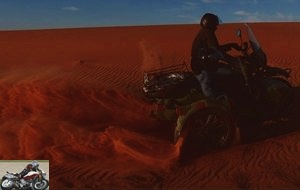
Consumption and maintenance
Big advantage of Ural on the consumption side: the switch to injection has lowered the average consumption of a good liter, or even a liter and a half to the hundred. From now on, you can flirt at a small 5 L / 100 on a ride, a small 7 L / 100 in heavy road use and a maxi at just over 8 L when the Ural is in demand, in the mountains, for example. Before, with carbs, it was impossible to go below 6 l / 100, we consumed 7.5 l / 100 at 90 cruising and not far from 10 l loaded like a baroud.
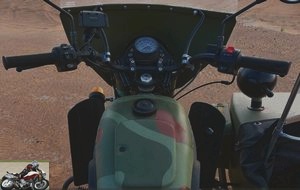
Here, the Triumph pays for its Dynojet kit and its glowing health! 8 l / 100 at 105 km / h cruising and 11 l at 120 is frankly unreasonable. During this test where I tried both sides in Morocco and where I transported the Triumph from Algeciras (E) to Perpignan, it was important to find the right cruising speed so as not to visit all the Spanish stations ! But there is no doubt that with an injected 2015 Scrambler, the consumption should be more reasonable and be around 7/8 l on average. Or, with the 16-liter tank, 200 kilometers of autonomy when the Ural easily hits 250 kilometers.
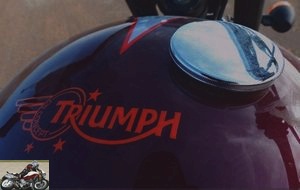
Big advantage of the Triumph in terms of maintenance: the Ural has to go to the workshop every 3000 km and the French network has only 12 dealers. It complicates the user’s life a bit. The Triumph, in addition to significantly higher reliability (that will make Ural owners scream, but it is a fact), will only pass through the Triumph network every 10,000 kilometers..
Convenient
Another Ural victory, so equipped that he lacks nothing! Do you know a lot of machines with a lockable trunk, additional lights, reverse gear, luggage racks? Yes, a car !
The Triumph is more conventional. The trunk does not lock, but can accommodate luggage for a consistent trip for two.

Conclusion
A side is used to have fun, but also and above all to travel. In this sense, our two machines achieve their goal! Our two machines already teleport you to a certain "elsewhere" just by turning the ignition key. Then, beyond a common base of skills, they each do it in their own way. The Triumph is more fun and more efficient, except in extreme conditions where the Ural will make its saving two-wheel drive speak..
The rest is a matter of taste. Placed on its big Mitas Enduro tires, the Scrambler Yeti has something of Steeve McQueen in it. A look that is both timeless and very trendy that would not go out of place in a hipster gathering. But she doesn’t just have a posture; its very balanced chassis and the character of its engine, whose power and torque curves seem to have been drawn on purpose for it so much that they are in phase with the cast driving intrinsically induced by this type of vehicle make it a very efficient side.
L’Ural is not about sensuality. Its raw look of formwork immediately announces the color as the profile of its owner, necessarily able to compose with a more rustic mechanism. The Ural is one of those rare devices that makes you pass off their (bad) character traits as personality elements and which their owners claim despite all rationality. In use, we understand their attachment to this piece of history, modernized and now injected !
Strong points
Ural
- Mythical brand
- Promise the end of the world…. at reduced speed
- Complete protection against the elements
- Full equipment
- 2 driving wheels
Triumph
- Look Steeve McQueen !
- Perfectly matched engine
- Hyper balanced chassis
Weak points
Ural
- Limited performance
- Physical conduct
- Caution and anticipation on the handlebars !
Triumph
The ural Ranger sidecar technical sheet
Test conditions
- Itinerary: 3,000 km to Morocco
Related articles
-
Triumph Street Twin and Street Scrambler test
Street of towns and fields Since 2016, the Triumph “Bonneville” Street Twin, with “medium” English displacement, has become the brand’s best-selling…
-
Cool There is freedom in the new Triumph Street Scrambler. A freedom that comes from afar to take you very far. A freedom that has its roots in the…
-
Honda CB650R and CBR650R motorcycle comparison test
Beneficial Redesign for the roadster and the streamlined roadster become sporty ? Engine and cycle parts optimized for the two 2019 Honda vintages Based…
-
Triumph Street Triple 765 RS test: the right number
Numerology French bikers are difficult, some would say. False, shall we say. They are experienced amateurs who prioritize quality and performance. This…
-
Triumph Sprint GT motorcycle test
Mister Hyde in velvet panties !! 3500 km test Triumph unveiled the Sprint GT in 2010, evolving into a more road version of the ST. Seen from the front,…
-
Triumph Scrambler 1200 XC & XE test
Free spirit A dynamic leader in the neo-retro segment, Triumph draws novelty after novelty for 2019, articulated around its two twin cylinders of 900 and…
-
Comparison test Triumph Tiger 900 GT Pro and Rally Pro
Annexation of new territories 3 cylinders in line, 888 cm3, 95.2 hp, 87 Nm, 198 kg and 201 kg, euros Although the creative nation of rugby, the English…
-
Triumph Street Triple 765 RS motorcycle test
The Moto2 roadster 3-cylinder engine, 765 cc, 123 HP, 79 Nm, 166 kg dry, € 11,900 Since its release in 2007, the Street Triple has been a real commercial…
-
4,000 km test When I first came up with the idea of going to Corsica to test the new Triumph T-Bird, I felt a hint of mockery in the editorial staff….
-
Triumph Bonneville Bobber Black test
2 cylinders in line, 1200 cc, 77 hp at 6100 rpm, 106 Nm at 4000 rpm, 237.5 kilos dry, from ¤ 14 350 More muscle, more techno, more dark for the Bobber Is…
+ the very nice little video.
Finally something new in the field of versatile two-wheelers.
Thank you Le Repaire with a very interesting and elegantly written essay.
Basically, a pity that Honda did not go to the end of the SUV concept with a 3008-style dashboard where the GPS can be integrated.
And since many will never do a TT with this vehicle, why not offer one-piece aluminum rims and belt drive to reduce maintenance. ?
But I nitpick, the alternative to my C650GT may be there …
Hello,
thank you.
The idea is not to copy the car. So not to make an automobile SUV. Honda took over the dashboard of one of its offroad machines. A very good idea.
The principle of this vehicle is precisely to be able to leave the roads … so chain and spoked rims are welcome..
As for your C650GT … yes, just mechanically, the Honda has "real mechanics" and a motorcycle cycle part. So I advise you to try the X-ADV…
V
Keep us in touch.
Hello,
I owned 2 T max 530, a C650 sport, including 2 changes of clutches under warranty, I wonder why BMW did not have this scooter designed and manufactured by Rotax, a robust engine specialty and reliable, in short my Percheron X adv knows how to do everything nicely and sometimes nervously except for his weight at a standstill, it is a Swiss army knife
Because Kymco offered a much cheaper (and less reliable …) block and that profitability takes precedence in this world…
A blue and white badge is not enough for the quality of a machine to be guaranteed. Far from it.
Still, I have two BMWs … but from 2000/2001. More reliable.
The X-ADV is surely a reference in terms of simple and reliable mechanical construction (NC motor).